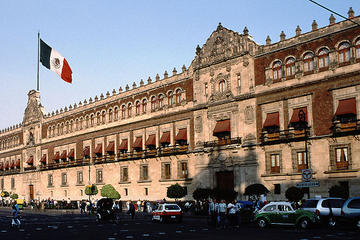
The seat of Mexico's federal government since the age of the Aztecs (at least), the National Palace - or Palacio Nacional - is a working building, and many offices are off limits to visitors. You can, however, pass through the enormous baroque facade dominating the eastern side of the Zócalo and enjoy some of its ample interior.
Though the arcaded courtyards and fountains are fine examples of Spanish colonial architecture, you're here to see artist Diego Rivera's triptych of murals, "Epic of the Mexican People." From the creation of humankind by Quetzalcóatl, the Feathered Serpent god, and subsequent rise of the Aztecs, Rivera plunges you into the horrors of the Spanish Conquest - rape, murder, slavery, and finally, mercy to the defeated survivors. In the final piece, Mexico's resistance to invasions by France, the United States, and corporate robber barons including Vanderbilt, Rockefeller and J.P. Morgan, are depicted.
There are many other works of art incorporated into the Palacio, which independent guides (some of whom speak English) waiting outside the northern door can explain. Independence Day is celebrated here on September 15.
The Palacio Nacional overlooks the Zócalo, more properly called Plaza de la Constitución, which has marked the city center since it was founded, as Tenochtitlán, in 1325. Though the Spanish razed the neighborhood's original Aztec buildings, they used the same stones to rebuild the capital city in Europe's image. According to legend, conquistador Hernán Cortés constructed this building with the Emperor Moctezuma's former palace.
Half a millennium, and several governments, later, this is still the center of all the action. All roads lead to the Zócalo, but you're much better off without a car - traffic is terrible and parking expensive. Instead, take the Metro Line 2 to the Zócalo stop, across from the Palacio Nacional. You must have a photo ID to enter.